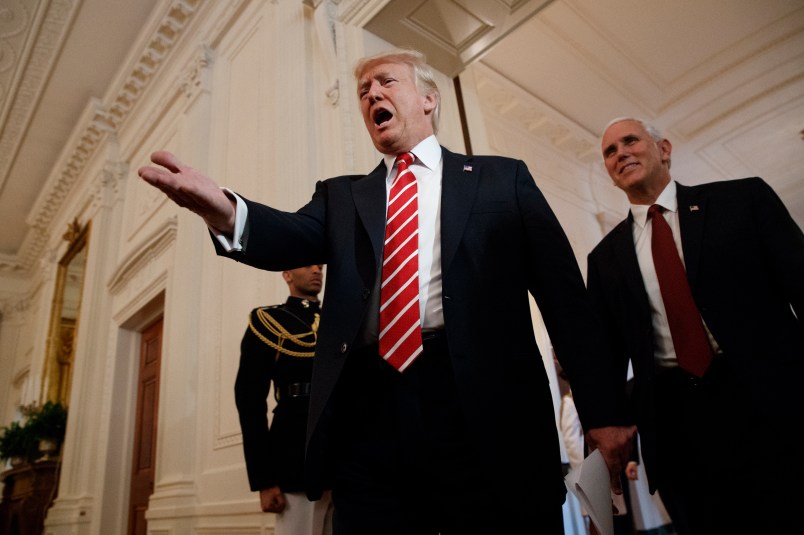I gave a talk yesterday in DC and in the Q&A I got a question about the outcome of the 2016 election which I ended up answering with what I’ve come to see as my general theory of what happened on November 8th. It’s not a complex or terribly surprising theory. It’s fairly simple. But since it is now implicit in a lot of the things I write I thought I would lay it out here for general purposes.
First, I think Russia’s interference in the 2016 election played a significant role in the outcome – perhaps a greater role than we yet understand. I think James Comey’s final days’ intervention did too. The peculiarities of the electoral college, which allowed Trump to become President with a minority of the vote, of course played a critical role, though of a very different sort. Yet it goes without saying that none of these factors bumped Trump from 35% or 40% of the two party vote to the margin he got. These factors, and the mix of these factors, helped tip a generally close race against Hillary Clinton and in Donald Trump’s favor. So what’s the more general theory of what happened? Here’s my theory. And again, I don’t claim that this understanding is either unique or particularly penetrating. I lay it out simply to provide some transparency into my thinking.
Through the 2016 election cycle Donald Trump ran a campaign which not only consolidated strong support from what we now call Trump’s ‘base’ (before that, the GOP base) but galvanized enthusiasm and eventually turnout that exceeded the expectations of many election experts. (At least the first part of the was entirely predictable.) I always thought that Trump’s election was quite unlikely because of a basic principle that had been validated in numerous previous elections: precisely the actions and positions which galvanized those levels of support on the hard right should have lost Trump more than enough in the middle of the electorate to rule out his election. But that didn’t happen. So why didn’t it happen?
I think a look at polling and, eventually, election result data over the course of 2016 tells the story. What I am describing did happen during the primaries. Trump deeply divided the GOP. In many ways he won the nomination with a plurality rather than a majority of support. During the election I frequently referenced one of my favorite quotes and insights from the insight, which came from Slate’s Will Saletan: “The GOP is a failed state. Donald Trump is its warlord.” To me this clever turn of phrase captures at a quite deep level why Trump was able to take over the GOP. The key though is that once Trump secured the Republican nomination, once he became the Republican and Hillary Clinton the Democrat, all the forces of asymmetric partisan polarization kicked into place and ensured that essentially all self-identified Republicans and Republican-leaning independents fell into line and supported Trump. This two step process is the story of the 2016 election. Long tested premises for how US politics works said that would not happen. And yet it did happen.
Obviously there is a smattering of GOP elites and commentators who have remained “Never Trump”, as the phrase had it. But election results and polling data tell the real story. At least through election day and to a surprising degree during his almost six months in office, Trump has been able to maintain historically high levels of support from self-identified Republicans – until recently in the high 80s and 90s percentages. That’s equal to or above what any Republican president in modern history has been able to garner. That fact, right there, is why Donald Trump won the election. The big structural answer is asymmetric partisan political polarization. It allowed a divisive factional leader in the GOP to become a figure who united the GOP.
Of course, an alternative theory might have it that Hillary Clinton was so unpopular or just so terrible that as bad as Trump was, people still chose him over her. A lot of people have a strong interest in this being true. And I think it is important for everybody to appreciate that the fact of Clinton’s unpopularity rather than its merits or justice was a big factor. Fundamentally though this gets the causation wrong. It wasn’t Clinton’s unpopularity that made Trump acceptable. It was partisan hyper-polarization that made someone who could reasonably be seen as a flawed candidate appear unacceptable in comparison to someone who, prior to the effects of that polarization kicking in, the great majority of the public recognized as manifestly unsuited to and unqualified for the job.
There were other factors at work certainly. Not just any crazy person could accomplish what Trump did. Trump embodies what I’ve come to think of as a ‘dominationist’ politics which profoundly resonates with the base of the GOP and has an expanding resonance across the party. Party leaders made the judgment that since they couldn’t defeat Trump they should join him, hoping he would deliver on a policy agenda favoring money and using public policy to center risk on individuals. That hope has been entirely confirmed. There are, as there are in every close election, a myriad of reasons why Trump won. But this is the factor that is structural, responsible on its own for a substantial amount of Trump’s support, and because it is structural quite likely to endure into future elections.






